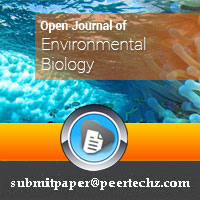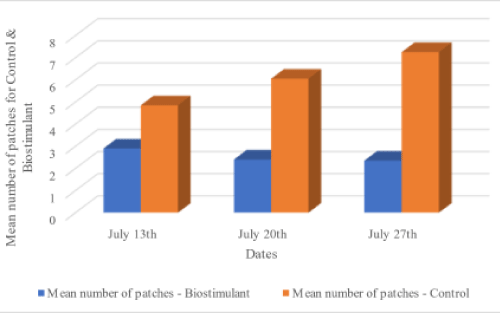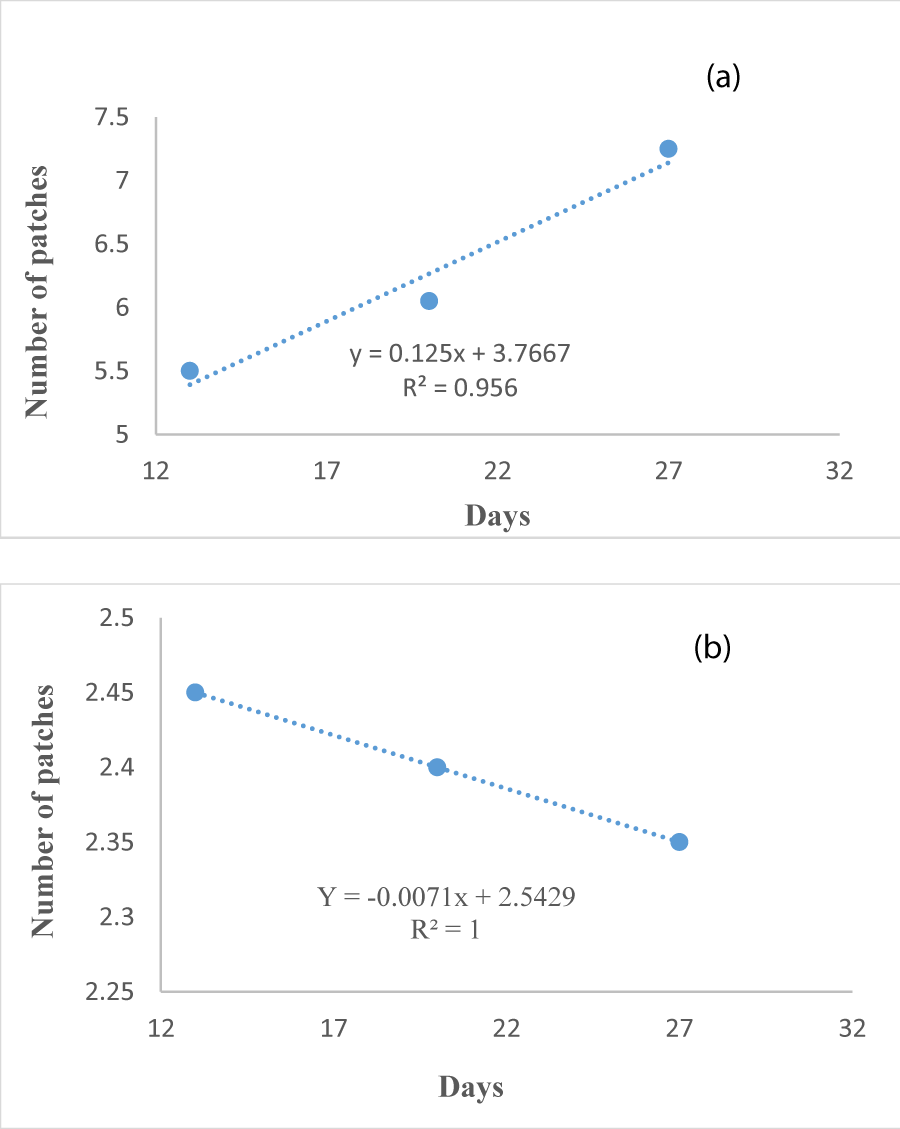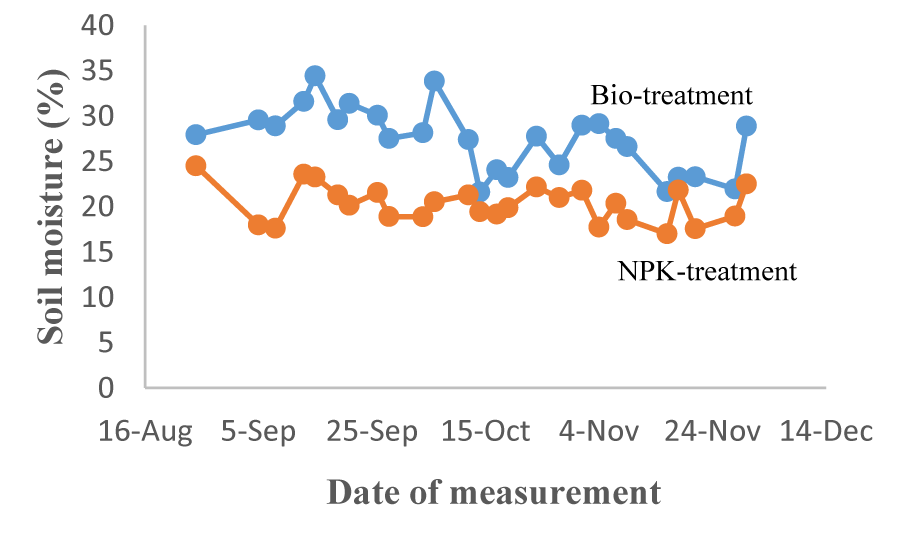Open Journal of Environmental Biology
Patch growth of seashore paspalum (Paspalum vaginatum) treated with inorganic fertilizer and organic biostimulant
Madison L Meagher1, Ambrose O Anoruo1*, Benjamin L Turner1, Paul W Holland2, Shad D Nelson3 and Maria C Donato-Molina1
2Department of Animal Science & Veterinary Technology, Texas A&M University-Kingsville, TX 78363, USA
3Dick and Mary Lewis Kleberg College of Agriculture & Natural Resources, Texas A&M University-Kingsville, TX 78363, USA
Cite this as
Meagher ML, Anoruo AO, Turner BL, Holland PW, Nelson SD, et al. (2024) Patch growth of seashore paspalum (Paspalum vaginatum) treated with inorganic fertilizer and organic biostimulant. Open J Environ Biol 9(1): 010-014. DOI: 10.17352/ojeb.000041Copyright
© 2024 Meagher ML, et al. This is an open-access article distributed under the terms of the Creative Commons Attribution License, which permits unrestricted use, distribution, and reproduction in any medium, provided the original author and source are credited.Inorganic fertilizers are often used in the United States in golf courses putting green maintenance. We used milled plant biomass on putting greens to test the hypothesis that organic biostimulants used in putting green maintenance can achieve similar results as inorganic fertilizers. Dilapidated putting greens, #4 and #14, with conspicuous patches at the L.E. Ramey Golf Course in Kingsville, TX, were selected for the study. Each green was split in half with one half selected for treatment and the other half maintained as the control and treated with NPK. Milled Medicago sativa L. mixed with milled high auxin-containing plant species in a ratio of 10:1 was used to test the hypothesis. The mixture was applied in the bio-treated section of the two greens while the golf course management continued to apply inorganic fertilizers on the control section of the study greens. Patch count on the greens was conducted once a week utilizing a randomly placed 1 by 1 m quadrant. Also, soil moisture measurement was taken twice a week on the greens to understand soil moisture retention due to the treatments. Patch count indicates that the bio-treated sections grew and filled significantly faster than the sections treated with inorganic fertilizers. Regression analysis of data collected between July 13th and July 27th indicates a strong linear biostimulant/patch growth relationship (R2 = 0.75 and 0.92) on Greens #4 and #14 respectively. Also, soil moisture data indicates significantly higher moisture retention on the putting green sections treated with the biostimulant.
Introduction
The golf industry is constantly growing larger in size and economic value, making golf an extremely popular sport with a high demand for perfectly managed golf courses with aesthetically pleasing features. Turf grass management is essential for the golfing industry, a multi-billion-dollar industry that creates thousands of jobs through supplies of turf grass seed, fertilizers, herbicides, insecticides, specialized machinery, and other common tools including sprinklers and hoses [1]. Proper turf grass management is extremely important to the golf industry and special attention should be given to the management of turf grass species used on golf putting greens. These species should be able to withstand the weather conditions prevalent in the area as well as the high foot traffic expected on golf-pumping greens. A part of proper maintenance of green turf grass in the United States is the ratio of applied NPK in which the specific concentration of each nutrient is optimal for the turf grass species requirement for optimum growth in length and thickness to achieve a smooth rolling green surface for an enjoyable golf game. Improper management of these nutrients can cause a golf green to develop patches resulting in injury and deterioration of the putting green. For non-golfers, the green of any golf course is the area at the end of the course fairway with grass mowed to the ground so the golf ball can roll smoothly unobstructed. So in a typical game of golf, the players aim their golf ball shots towards the putting green to drop the golf ball into the hole located on the putting green. Since the goal of a golf game is to aim the golf ball as accurately as possible into the hole, putting greens must maintain a smooth thickness to ensure that the golf ball rolls smoothly into the hole with little possibility of disruption to the ball’s trajectory to the hole.
This L.E. Ramey Golf Course is a 216 ha golf course located at 27.516o N and 97.856 o W in Kingsville, Texas, USA. The golf course is part of the former Naval Air Base donated to Kleberg County by the United States Government in 1973. The course consists of 18 holes that span a combined four-mile length for a par 72 golf course game. The course is surrounded by lush mesquite trees with natural ponds that provide obstacles and challenges for golfers [2]. The maintenance of the course includes daily watering of the golf greens using a sprinkler system. The greens are watered about four times a day in the summer at intervals of 20 minutes for a total of 80 minutes of watering per day. Sixteen of the 18 golf greens at the golf course have been replaced three times in 2018, 2020, and 2022 due to the development of patches resulting in noticeable injury [2]. Of the 9 turf grass species used for golf greens in Texas, seashore paspalum is the most adapted to the local weather conditions in Kingsville located in the semi-arid region of the United States. The winters are mild with a few thunderstorms in the spring. The summer temperatures are hot with average temperatures between 29 oC – 39 oC [3]. These conditions match the species' natural growth conditions classified as either warm-season grass, cool-season grass, or transition zone grass species that thrive in both warm and cool climate regions [4]. The salinity of the City of Kingsville freshwater supply which the golf course uses in putting green irrigation has been known to contain up to 6.86 mS/cm [5].
Thus, a combination of factors, including the arid climatic conditions of Kingsville, high spring and summer temperatures which could cause quick putting green desiccation, high salinity levels of the freshwater supply used in golf course irrigation, and the use of inorganic fertilizers which could burn the greens at the high-temperature conditions of the area may have caused the damage and injury of the greens and consequently led to the constant replacement of the putting greens. This study evaluates the effects of an organic biostimulant on patch growth and development of seashore paspalum (Paspalum vaginatum) on putting greens #4 and #14 which have not yet been replaced by the L.E. Ramey Golf Course management. These greens have suffered noticeable and measurable injuries and are in line for replacement.
Materials and methods
Each green (#4 or #14) used in the study was split in half, with one half selected for bio-treatment while the other half was maintained as the control and treated with inorganic fertilizer according to the golf course management. The bio-treated and control sides of the study putting greens were determined based on runoff from the sprinkler watering system such that the section treated with inorganic fertilizer would not run off into the bio-treated section. This was necessary to avoid contamination of the bio-treatment with runoff from the NPK treatment. Dry alfalfa (Medicago sativa L) milled to powder was mixed with the booster (milled high auxin-containing plant species) in a 10:1 ratio respectively. The mixture was applied on June 24, 2023, to the bio-treated side of the study greens with a centrifugal spreader and repeated weekly thereafter. Patch count was conducted on both the bio- and NPK-treated sides of the greens before the initial application of the biostimulant treatment while the L.E. Ramey Golf Course management continued to apply inorganic fertilizers on the control section of the study greens. The course management applies various liquid fertilizers on the golf greens every two weeks. The liquid fertilizers consist of seven different fertilizers mixed in 250 gallons of water and applied monthly in the spring and summer seasons with a manual hand sprayer. A complete recipe of liquid fertilizer application at the golf course consists of three gallons of Ruckus, 1.5 gallons of Comp M, 1.5 gallons of Comp CaB, one gallon of NutriPath, 1.5 gallons of Backbone, six gallons of Comp Classic, and six gallons of Comp N but the quantity of this mixture applied at each feeding time may vary due to temperatures. The golf greens are mowed every other day in the morning hours at 2.54 – 10.16 cm high.
Environmental research studies often involve confounding variables which must be managed to reduce or eliminate errors and other sources of bias due to the variables. These variables include a variety of weather and edaphic conditions which must be managed to reduce or eliminate their impact on the data. To ensure that the information collected was due to the treatments, we collected data the same day and no more than 30 minutes apart from adjoining treatments. Patch counts on the bio- and NPK-treated sections of Green #4 and Green #14 were conducted once a week utilizing a randomly placed 1 by 1 m quadrant. Ten quadrants were counted each measurement day for each treatment per green, with a total of 10 measurement days per green for the duration of the study. Thus 100 quadrants were counted per treatment per green for a total of 200 quadrants per green (100 quadrants for the bio-treated section and 100 quadrants for the NPK-treated control). After 5 weeks of treatment (3rd measurement), the L.E. Ramey Golf Course management demanded the entire study greens (Green #4 and Green #14) be placed under bio-treatment. Soil moisture measurements were conducted twice a week on the greens with an Extech MO750 soil moisture meter by Teledyne FLIR LLC to understand moisture retention on the study greens. A total of 26 soil moisture measurements were conducted for the study.
Results
Paired t-tests and regression statistics were adopted to compare the effects of an organic biostimulant treatment on the growth and development of golf-putting green seashore paspalum to the growth and development of the species treated with inorganic fertilizers. The paired t-test compared the number of patches on the bio-treated versus NPK-treated sections of each green using data collected from July 13th to July 27th, 2024 before the golf course management required bio-treatment on all sections of the study greens. The analysis indicates a significant difference in the number of patches between the NPK-treated control and bio-treated sections of Green #4 (p = 0.0132). A similar result was also obtained between the NPK-treated control and bio-treated sections of Green #14 (p = 0.0422). To decipher the actual effect of the treatment and gain a holistic understanding of the results, the number of patches on both greens was combined for further statistical analysis. The paired t-test of the data indicates a significant difference between the biostimulant-treated sections of both greens compared to the NPK-treated control sections (p = 0.0006). The analysis also shows that patches on the sections of both greens treated with the biostimulant continued to decrease in number compared to the increasing number of patches on the control sections treated with inorganic fertilizers (Figure 1). A simple regression analysis of the combined patch count on greens #4 and #14 before the bio-treatment was extended to the control indicates that the NPK treatment is a culprit in patch development on the greens (R2 = 0.96, Figure 2a), while patch count on both greens declined (R2 = 1) with the bio-treatment (Figure 2b).
The request by golfers prompted the L.E. Ramey Golf Course management to require bio-treatment on the entire study greens i.e. on the NPK-treated-control and bio-treated sections of both greens. The paired t-test compared the number of patches on the NPK-treated control to the number of patches on the bio-treated section of each green from August 3rd to September 14th, 2024 i.e. when the demand was made to the end of the study. The analysis indicates no significant difference in the number of patches between the control and bio-treated section of Green #4 (p = 0.0564). Green #14 gave a similar result (p = 0.2946). However, when the patch count on those dates was combined and analyzed, a statistically significant difference was discernable in patch growth (p = 0.0300). These results are a major sign of the efficacy of the treatment with patch count trending downward even on the NPK-treated control after bio-treatment was extended to it (Figure 3).
A comparison of soil moisture retention of the study greens indicates a significantly higher soil moisture retention by the bio-treatment than the NPK-treated control of the study greens (p < 0.0001). The mean soil moisture retention for the NPK-treated control of Green #4 is 21.45% compared to 25.54% of the bio-treatment section of the green. A similar result is also true of Green #14 with mean soil moisture retention for the NPK-treated control of 19.13% compared to 29.30% of the bio-treatment section of the green. The difference in soil moisture retention by both greens due to the treatments holds for all soil moisture measurements throughout the study (Figure 4).
Discussion
There are over 700 identified grass species in the state of Texas but only 12 are utilized as turf grass, and 9 out of the 12 are recommended for use as golf putting green turf of which seashore paspalum (Paspalum vaginatum) is one [1]. These 9 thrive in different regions of the state due to the climate conditions of the regions hence they are classified as either warm-season grass, cool-season grass, or transition zone grass [4]. Seashore paspalum, Paspalum vaginatum, a warm season turf grass, grows optimally in temperatures ranging from 27 °C to 35 °C and is only adapted to southeastern regions of the state of Texas. The species tolerates high salinity and high foot traffic and it is susceptible to cooler temperatures, and sudden temperature drops can cause irreversible damage or death of the species [6,7]. The City of Kingsville freshwater has high salinity (6.86 mS/cm) which provides optimal growth conditions for some grass species [8,9]. Also, the species has a dense rooting habit because of its ability to develop both rhizomes and stolons [10], an adaptation for efficient nutrient absorption especially in nutrient-poor soils [11] and stress tolerance due to high foot traffic [12].
Nitrogen fertilization has been recommended and used in golf course green maintenance [13,14] and some [15] suggested that nitrogen fertilization increases the resistance, and wear and tear of golf greens due to foot traffic. While these may well be true, nitrogen fertilization could become a problem in semi-arid regions with high temperatures as in Kingsville where the scorching heat causes rapid evaporation leaving fertilizer salts on the surface. These salts burn the turf resulting in the unpleasant formation of patches as in the case of this study. To circumvent this condition, we formulated an organic biostimulant comprising Medicago sativa mixed with a booster (a high auxin-containing plant species). The specific details of the high auxin-containing plant species are withheld because of intellectual property protection as this new product is still being studied and formulated. Medicago sativa is a nitrogen-fixing species [16-18] and has been reported to contain 3:1:2 NPK [19] which is released slowly following decomposition. The decomposition process was circumvented by using the milled product of the species dry biomass in the treatment.
We used mostly paired t-test statistics to decipher the results of this study. Environmental data are influenced by a myriad of conditions including humidity, temperature, precipitation, wind, and even the quality of solar radiation. Therefore, it is most appropriate to pair information obtained minutes apart on the day. This is designed to normalize any variation due to environmental factors. The results of the study indicate that NPK fertilization contributes to the creation of patches on the study greens. This is evident from the analysis of the first month of treatment before the golf course management required bio-treatment on the entire greens. At this time, the patch number was still increasing on the NPK-treated control sections of the two study greens (Figs.1 and 2a). The increasing number of patches on the NPK-treated sections and the bumpy surface the patches created obstructed the golf ball's smooth roll on the greens hence the demand by golfers to extend the bio-treatment on the entire greens. This is also an unbiased testimony in support of the efficacy of the bio-treatment. Additionally, the results also indicate that patch growth increased resulting in a decrease in the number of patches when the bio-treatment was extended to the NPK-treated control of the study (Figure 3). This further supports the efficacy of the bio-treatment compared to the NPK treatment as a nutrient source to the study golf greens.
Soil moisture analysis also shows that the bio-treated sections of the greens retained more moisture than the NPK-treated sections (Fig. 4). This result is consistent on both greens and applies to all moisture measurements throughout the study. The results suggest that the milled plant biomass may have acted as a natural absorbent polymer and retained moisture on the greens longer than the NPK-treated control sections of the greens. Although this is an important result in support of the biostimulant treatment, it has created uncertainty as to what exactly induced better growth of seashore paspalum in the bio-treated sections of the study greens. Is it the gradual nutrient release by the biostimulant or the propensity of the bio-treated sections to retain more moisture because of the milled plant fiber acting as a natural absorbent polymer? Retention of moisture by milled plant biomass acting as absorbent polymer could make the difference in the growth of Paspalum vaginatum in a semi-arid environment as is obtainable in Kingsville. This uncertainty needs further investigation.
Conclusion
We conclude that milled plant biomass can be used in golf putting green management to obtain a similar result as with NPK management. The evidence discussed above leads to the adoption of the hypothesis of the study. The data suggests that NPK fertilization contributes significantly to patch creation and development at the Ramey Golf Course in Kingsville, TX, USA. The biostimulant treatment resulted in better seashore paspalum growth at the patches but we are uncertain what biostimulant resource, nutrient or water holding potential, led to the observed growth of the species.
Support for the moisture studies component of this research was provided by the NSF-CREST Sustainable Water Use grant, Award No. 1914745. We also acknowledge the help of our students in field data collection.
- Shaw RB, Montgomery P. Guide to Texas grasses 2012. Texas A&M University Press
- Ramey LE. The LE. Ramey Golf Course Official Golf Course Guide 2020. Bench Craft Company. Portland, Oregon, USA
- Weather S. The weather history in Kingsville, TX, USA 2022. Cedar Lake Ventures, Inc, Minnesota.
- Casler MD, Duncan RR. Turfgrass biology, genetics and breeding John Wiley & Sons 2003, New York, USA.
- Anoruo AO, Turner BL, Garcia MR, Nelson SD, Donato-Molina MC. Morphological and anatomical development of Solanum Lycopersicum seedlings grown with non-conventional water. Int J Agri Res Env Sci. 2024; 5(1):1‒4.
- Chalmers DR, McAfee J. Turfgrass selection for Texas: Ecological turf tips AgriLife Extension. 2010. Texas A&M University System.
- Lee G, Carrow RN, Duncan RR. Criteria for assessing salinity tolerance of the halophytic turfgrass seashore paspalum. Crop Sci. 2005; 45(1):251-258.
- Dudeck AE, Peacock CH. Effects of salinity on seashore paspalum turfgrasses. Agron J. 1985; 77(1):47-50.
- Lee G. Comparative salinity tolerance and salt tolerance mechanisms of seashore Paspalum ecotypes. Ph.D. Dissertation 2000. The University of Geogia, Athens, GA, USA.
- Duncan RR, Carrow RN. Seashore paspalum: The environmental turfgrass. John Wiley 2013, New York, USA.
- Chapin FS, Matson PA, Vitousek PM. Principles of Terrestrial Ecosystem Ecology 2011. Springer LLC, New York.
- Guo H, Wang Y, Li D, Chen J, Zong J. Growth response and ion regulation of seashore Paspalum accessions to increasing salinity. Environ Exp Bot. 2016; 131:137-145.
- Balogh JC, Walker WJ. Golf Course Management and Construction. Environmental Issues. CRC Press, Taylor & Francis Group; 2019.
- Duncan RR, Carrow RN. Managing seashore paspalum greens under proper management. USGA 2005:114-118.
- Trenholm LE, Carrow RN, Duncan RR. Wear tolerance, growth, and quality of seashore Paspalum in response to nitrogen and potassium. HortScience. 2001; 36(4):780-783.
- Kelner DJ, Vessey JK, Entz MH. The nitrogen dynamics of 1-, 2- and 3-year stands of alfalfa in a cropping system. Agric Ecosyst Environ. 1997; 64(1):1-10.
- Heichel GH, Barnes DK, Vance CP. Nitrogen fixation of alfalfa in the seeding year. Crop Sci. 1981; 21(2):330-335.
- Vance CP, Heichel GH, Barnes DK, Bryan JW, Johnson LE. Nitrogen fixation, nodule development, and vegetative regrowth of alfalfa (Medicago sativa L.) following harvest. Plant Physiol. 1979; 64(1):1-8.
- Lebaka R, Turner B, Nelson S, Anoruo A. Studies on production of Anaheim pepper in greenhouse media supplemented with organic and inorganic nutrient sources, and water conservation. J Hortic Sci. 2023; 18:1-6.

Article Alerts
Subscribe to our articles alerts and stay tuned.
 This work is licensed under a Creative Commons Attribution 4.0 International License.
This work is licensed under a Creative Commons Attribution 4.0 International License.





 Save to Mendeley
Save to Mendeley
